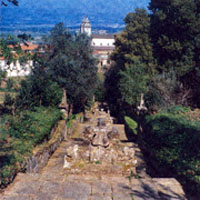
Cerca do Mosteiro de Tibães
The International Carlo Scarpa Prize for Gardens
IX Annual Award, 1998
The Jury of the International Carlo Scarpa Prize for Gardens has unanimously decided unanimously to award the 1998 prize, the ninth in the series, to the Cerca do Mosteiro de Tibães, a vast estate with woods, orchards, vegetable and flower gardens, lakes and canals, buildings and stone sculptures, created by Benedictine monks on the slopes of the São Gens mountain towards the town of Mire de Tibães and the River Cávado, near the city of Braga in the region of Minho in the far north of Portugal.
The cultural landscape, which originally covered an area of 40 hectares surrounded by a high wall, was established around the Benedictine Monastery of Saint Martin of Tibães. It occupies a particularly fertile natural site between the ocean and the mountains, with frequent heavy rains supplying the many springs and streams; a place where over thousands of years man has developed remarkable skills in governing water and using materials from granite to wood, from clay to gold and in exploiting a profound knowledge of the plant world and its infinite receptiveness to experiment.
The Benedictine monks left their marks on the landscape in several stages: the original settlement from the X to the XIII century, the long, late-mediaeval crisis of the Counter Reformation and the revival from the late 1500s to the end of the XVIII century, when Tibães stood at the head of all the Benedictine monasteries in Portugal and Brazil.
The following two centuries, without the presence of the monks, were a period of neglect and decay until the estate was purchased by the State in 1986 and entrusted to the Instituto Português do Património Arquitectónico. It is this revival of attention, plans and concrete action that provides the focus for the award of the ninth International Carlo Scarpa Prize for Gardens.
The Jury’s unanimous decision focuses attention on a geographical area that is little studied and has too often been underappreciated.
A varied, lively and distinctive panorama of personalities and events underlies the Portuguese landscape. The role and development of the agrarian scene, the quality and order of the agriculture, the attention to detail in the vineyards, the pride in agricultural labour in a country where seafaring is a fact of nature and where feelings and interests are constantly drawn to the ocean.
To understand these apparent paradoxes one must rethink the texture and interplay of cultural and anthropological relations experienced by Portugal with other geographical regions as distant as India and nearer to hand such as the Arab or Flemish.
Text taken from the 1998 Carlo Scarpa Prize Statement, edited by the Jury.
